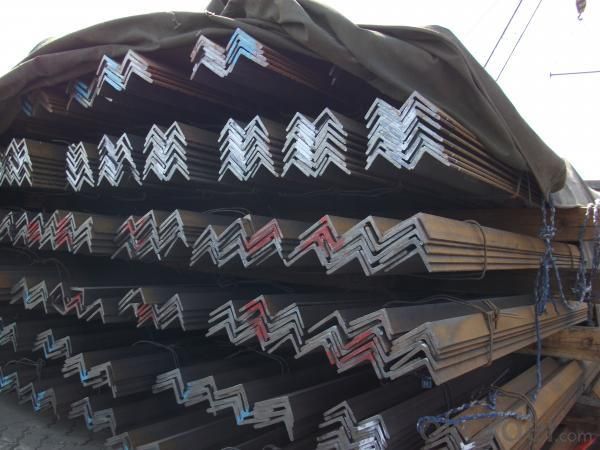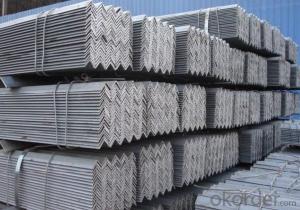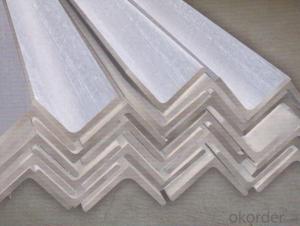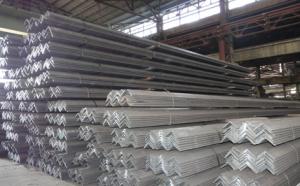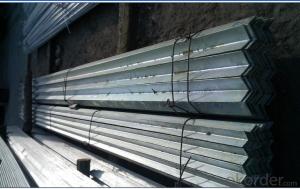Angle Steel
- Loading Port:
- China Main Port
- Payment Terms:
- TT or LC
- Min Order Qty:
- 25mtons m.t.
- Supply Capability:
- 80000-100000MTS/YEAR m.t./month
OKorder Service Pledge
OKorder Financial Service
You Might Also Like
Specifications of Angle Steel
1. Invoicing on theoretical weight or actual weight as customer request
2. Length: 6m, 9m, 12m as following table
3. Sizes

Sizes: 25mm-250mm | ||
a*t | ||
25*2.5-4.0 | 70*6.0-9.0 | 130*9.0-15 |
30*2.5-6.6 | 75*6.0-9.0 | 140*10-14 |
36*3.0-5.0 | 80*5.0-10 | 150*10-20 |
38*2.3-6.0 | 90*7.0-10 | 160*10-16 |
40*3.0-5.0 | 100*6.0-12 | 175*12-15 |
45*4.0-6.0 | 110*8.0-10 | 180*12-18 |
50*4.0-6.0 | 120*6.0-15 | 200*14-25 |
60*4.0-8.0 | 125*8.0-14 | 250*25 |
5. Payment terms:
1).100% irrevocable L/C at sight.
2).30% T/T prepaid and the balance against the copy of B/L.
3).30% T/T prepaid and the balance against L/C
6.Material details:
Alloy No | Grade | Element (%) | |||||
C | Mn | S | P | Si | |||
|
|
|
|
|
|
| |
Q235 | B | 0.12—0.20 | 0.3—0.7 | ≤0.045 | ≤0.045 | ≤0.3 | |
|
|
|
|
|
|
| |
Alloy No | Grade | Yielding strength point( Mpa) | |||||
Thickness (mm) | |||||||
≤16 | >16--40 | >40--60 | >60--100 | ||||
≥ | |||||||
|
|
|
|
|
| ||
Q235 | B | 235 | 225 | 215 | 205 | ||
Alloy No | Grade | Tensile strength (Mpa) | Elongation after fracture (%) | ||||
Thickness (mm) | |||||||
| ≤16 | >16--40 | >40--60 | >60--100 | |||
≥ | |||||||
|
|
|
|
|
|
| |
Q235 | B | 375--500 | 26 | 25 | 24 | 23 | |
Usage & Applications of Angle Steel
According to the needs of different structures, Angle can compose to different force support component, and also can be the connections between components. It is widely used in various building structures and engineering structures such as roof beams, bridges, transmission towers, hoisting machinery and transport machinery, ships, industrial furnaces, reaction tower, container frame and warehouse etc.
Packaging & Delivery of Angle Steel
1. Packing: it is nude packed in bundles by steel wire rod
2. Bundle weight: not more than 3.5MT for bulk vessel; less than 3 MT for container load
3. Marks:
Color marking: There will be color marking on both end of the bundle for the cargo delivered by bulk vessel. That makes it easily to distinguish at the destination port.
Tag mark: there will be tag mark tied up on the bundles. The information usually including supplier logo and name, product name, made in China, shipping marks and other information request by the customer.
If loading by container the marking is not needed, but we will prepare it as customer request.
Production flow of Angle Steel
Material prepare (billet) —heat up—rough rolling—precision rolling—cooling—packing—storage and transportation
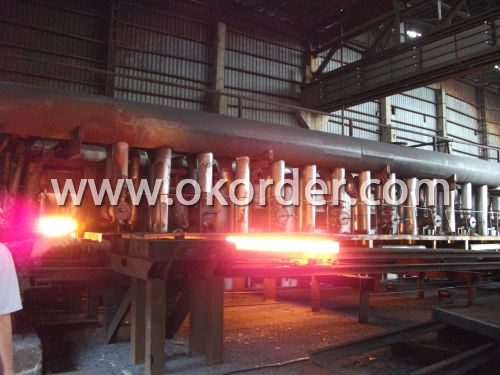
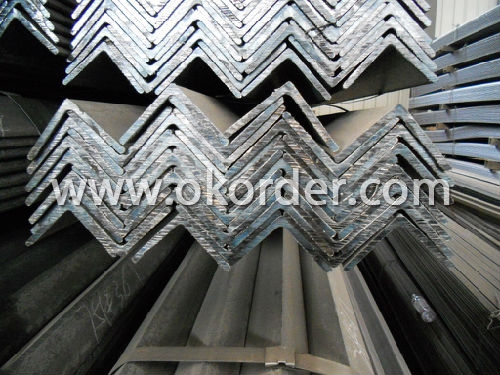
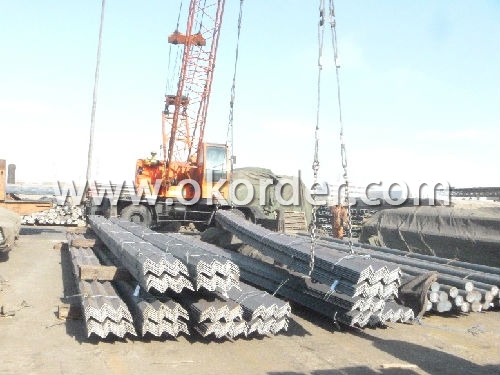
- Q: Can steel angles be used for architectural detailing?
- Indeed, architectural detailing can make use of steel angles. These versatile structural elements find application in diverse architectural scenarios. They serve to provide stability and support to structures, fulfilling framing, bracing, and reinforcing purposes. Examples of steel angle implementation can be observed in architectural features like window frames, door frames, staircases, and handrails, among others. Their inherent strength and durability render them fitting for both interior and exterior architectural designs. Furthermore, steel angles can be effortlessly tailored and manufactured to meet precise design specifications, empowering architects to conceive distinctive and visually appealing architectural details.
- Q: What are the different methods of surface galvanizing for steel angles?
- Steel angles can be surface galvanized using various methods, each with its own benefits and uses. Here are some commonly employed techniques: 1. Hot-dip galvanizing: The most widely utilized method involves immersing steel angles in molten zinc, forming a strong bond with the surface. This process offers exceptional corrosion protection and durability, making it suitable for a wide range of applications. 2. Electro-galvanizing: This method involves electrodepositing a thin layer of zinc onto the steel angle's surface. It is a controlled process that provides a smoother and more even coating. Electro-galvanizing is often used for decorative purposes or when a thinner coating is sufficient. 3. Sherardizing: This method entails coating the steel angles with a mixture of zinc dust and proprietary filler materials, such as aluminum or iron powder. The coated angles are then heated in a furnace, causing zinc to diffuse into the steel's surface, forming a durable alloy layer. Sherardizing is ideal for applications requiring high resistance to wear and abrasion. 4. Mechanical galvanizing: Also known as centrifuge galvanizing, this method involves tumbling steel angles in a drum or barrel with zinc powder and glass beads. The tumbling action helps zinc powder adhere to the surface, creating a protective coating. Mechanical galvanizing is commonly used for small or intricate parts that are challenging to galvanize with other methods. 5. Zinc-rich paint: Although not a conventional galvanizing method, zinc-rich paint can offer similar corrosion protection. It involves applying a paint or coating with a high concentration of zinc particles to the steel angle's surface. These zinc particles act as sacrificial anodes, corroding instead of the steel and safeguarding against rust and corrosion. These methods represent just a few options for surface galvanizing steel angles. The choice of technique depends on factors such as desired corrosion protection, specific application requirements, and cost considerations. Consulting with a galvanizing professional is crucial to determine the most suitable method for your needs.
- Q: Can steel angles be used in the construction of government buildings?
- Yes, steel angles can be used in the construction of government buildings. Steel angles are commonly used in construction due to their strength, durability, and versatility. They are often used for structural support, framing, and reinforcement in various building projects, including government buildings.
- Q: What are the cost considerations for using steel angles?
- When using steel angles, there are several factors to keep in mind regarding costs. Firstly, the price of the steel material itself can vary depending on the grade and quality. Higher-grade steel angles tend to be pricier but offer better strength and durability. The overall cost is also influenced by the length and size of the steel angles. Longer and larger angles generally come at a higher price due to the increased amount of steel needed. It is important to carefully assess the required dimensions to avoid unnecessary expenses. Another cost consideration is the fabrication and finishing of the steel angles. Custom fabrication or special finishing techniques like welding, cutting, or painting can add to the total cost. It is crucial to take these additional expenses into account when budgeting for the use of steel angles. Transportation costs should not be overlooked either. Steel angles are heavy and bulky, which can result in higher shipping expenses, especially for long distances. It is essential to factor in these costs, especially for projects that require a significant quantity of steel angles. Lastly, it is important to consider the long-term costs associated with steel angles. While steel is durable and long-lasting, it may require maintenance or protective coatings to prevent corrosion over time. These maintenance costs should be included in the overall budget to ensure the longevity and reliability of the steel angles. In summary, the cost considerations for using steel angles include the price of the steel material, the dimensions and size of the angles, fabrication and finishing processes, transportation expenses, and long-term maintenance costs. Evaluating and planning for these factors will help ensure a cost-effective and successful use of steel angles in various applications.
- Q: What is the maximum deflection for a steel angle beam?
- The maximum deflection for a steel angle beam depends on several factors including the dimensions of the beam, the material properties of the steel, and the applied load. It is calculated using engineering principles and can be determined using formulas and calculations specific to the beam's geometry and loading conditions. Therefore, without specific information about these factors, it is not possible to provide a definitive answer to the maximum deflection of a steel angle beam.
- Q: What is the typical density of steel angles?
- Steel angles can have varying densities depending on the particular steel type and grade employed. On average, their density falls within the range of 7.7 to 8.1 grams per cubic centimeter (g/cm³), or equivalently 7700 to 8100 kilograms per cubic meter (kg/m³). In comparison to other substances, steel angles possess a notably high density, imparting strength and durability for a multitude of structural and construction purposes.
- Q: How do steel angles contribute to the sustainability of a city?
- Steel angles contribute to the sustainability of a city in several ways. Firstly, steel angles are a crucial component in the construction industry, used in the fabrication of buildings, bridges, and other infrastructure. Steel is known for its strength, durability, and resistance to external factors such as corrosion and fire. By using steel angles in construction projects, cities can ensure the longevity and safety of their structures, reducing the need for frequent maintenance or replacement. This leads to a significant reduction in the consumption of resources over time, making cities more sustainable. Additionally, steel angles offer design flexibility, allowing architects and engineers to create innovative and efficient structures. Their versatility enables the construction of sustainable buildings that incorporate features such as energy-efficient designs, natural lighting, and effective insulation. By utilizing steel angles in the construction process, cities can promote sustainable practices and reduce energy consumption, contributing to a more sustainable urban environment. Furthermore, steel is a highly recyclable material, with a recycling rate of around 90%. By using steel angles in construction, cities can contribute to a circular economy by promoting the recycling and reuse of steel products. This reduces the demand for raw materials and minimizes waste, thereby reducing the environmental impact of construction projects. The use of recycled steel also helps to conserve energy and reduce greenhouse gas emissions associated with the production of new steel. In conclusion, steel angles play a vital role in the sustainability of a city by providing durable and long-lasting structures, enabling energy-efficient designs, and promoting the recycling and reuse of materials. By incorporating steel angles in construction projects, cities can create sustainable infrastructure that contributes to the overall well-being of the environment and the community.
- Q: How do you calculate the slenderness ratio of a steel angle?
- To calculate the slenderness ratio of a steel angle, you need to determine the length and the moment of inertia of the angle section. The slenderness ratio is a measure of how slender or slender a member is, and it helps in determining its stability and ability to resist buckling. First, measure the length of the steel angle, which is the distance between its two ends. This length should be measured in the same unit as the dimensions of the angle section. Next, calculate the moment of inertia of the steel angle section. The moment of inertia is a measure of the section's resistance to bending and is typically denoted by the symbol "I". It depends on the dimensions of the angle section and can be obtained from reference tables or calculated using mathematical formulas. Once you have the length and moment of inertia of the steel angle, you can calculate the slenderness ratio using the formula: Slenderness ratio = (Length of angle) / (√(Moment of inertia)) Make sure the length and moment of inertia are expressed in the same unit before performing the calculation. The resulting slenderness ratio will be a dimensionless value. It is important to note that the slenderness ratio is used to determine the appropriate design criteria and allowable loads for the steel angle. Different design codes or standards may have specific limits or guidelines for the maximum slenderness ratio that can be used safely in different applications. Therefore, it is crucial to consult the relevant design codes or seek professional engineering advice to ensure the correct and safe use of the steel angle.
- Q: What is the minimum bend radius for a steel angle?
- The minimum bend radius for a steel angle depends on several factors such as the thickness of the angle, the type of steel, and the specific application. It is recommended to consult the manufacturer or a structural engineer to determine the appropriate minimum bend radius for a steel angle in a particular situation.
- Q: What are the different methods of surface preparation for steel angles before painting?
- There are several methods of surface preparation for steel angles before painting. The choice of method depends on the condition of the steel surface and the desired level of paint adhesion and durability. One common method is abrasive blasting, also known as sandblasting. This involves propelling abrasive particles against the steel surface to remove rust, mill scale, and other contaminants. Abrasive blasting not only cleans the surface but also creates a rough profile, which improves the adhesion of the paint. Chemical cleaning is another method used to prepare steel angles for painting. It involves the use of chemical solutions or solvents to remove grease, oil, and other organic contaminants. This method is particularly useful for removing stubborn contaminants that cannot be removed by abrasive blasting alone. Mechanical cleaning methods, such as wire brushing or grinding, can be used to remove loose rust, scale, and old paint. These methods are suitable for smaller areas or localized rust spots. In some cases, power tool cleaning may be sufficient. This involves using power tools such as grinders, sanders, or wire brushes to clean the steel surface. However, it is important to ensure that these tools do not create a polished or smooth surface, as this can reduce paint adhesion. After the surface has been cleaned, it is important to remove any residual contaminants by using a solvent wipe or a clean cloth soaked in a suitable solvent. This step ensures that the surface is free from any remaining contaminants that could affect the paint adhesion. Finally, the steel angles should be primed before painting. A primer provides additional corrosion protection and enhances the adhesion of the topcoat. The choice of primer depends on the specific requirements of the project, such as exposure to harsh weather conditions or chemical exposure. Overall, the different methods of surface preparation for steel angles before painting include abrasive blasting, chemical cleaning, mechanical cleaning, power tool cleaning, solvent wiping, and priming. Selecting the appropriate method ensures that the paint adheres well to the steel surface and provides long-lasting protection against corrosion.
1. Manufacturer Overview
| Location | Hebei, China |
| Year Established | 2003 |
| Annual Output Value | Above US$ 500 Million |
| Main Markets | Southeast Asia; middle east; South Korea; Africa |
| Company Certifications | ISO 9001:2008 |
2. Manufacturer Certificates
| a) Certification Name | |
| Range | |
| Reference | |
| Validity Period |
3. Manufacturer Capability
| a) Trade Capacity | |
| Nearest Port | Tianjin |
| Export Percentage | 30%-45% |
| No.of Employees in Trade Department | 11-20 People |
| Language Spoken: | English; Chinese |
| b) Factory Information | |
| Factory Size: | Above 10,000 square meters |
| No. of Production Lines | 2 |
| Contract Manufacturing | OEM service offered |
| Product Price Range | high; average |
Send your message to us
Angle Steel
- Loading Port:
- China Main Port
- Payment Terms:
- TT or LC
- Min Order Qty:
- 25mtons m.t.
- Supply Capability:
- 80000-100000MTS/YEAR m.t./month
OKorder Service Pledge
OKorder Financial Service
Similar products
Hot products
Hot Searches
Related keywords



